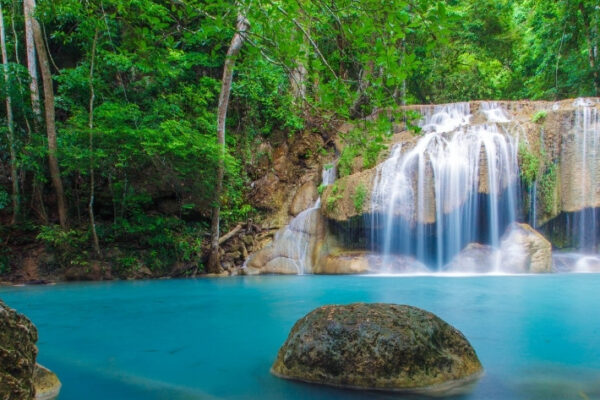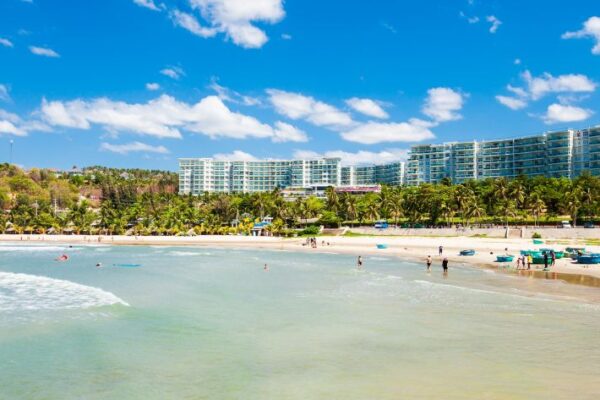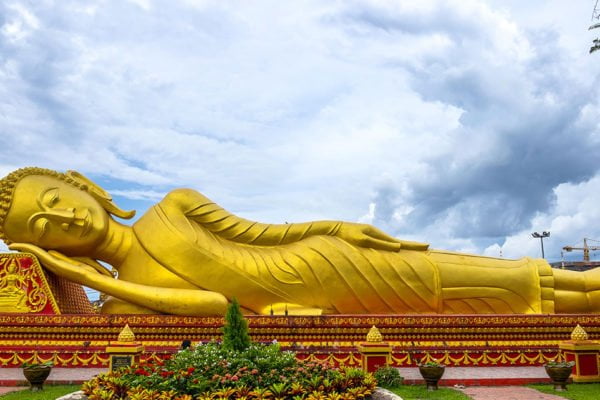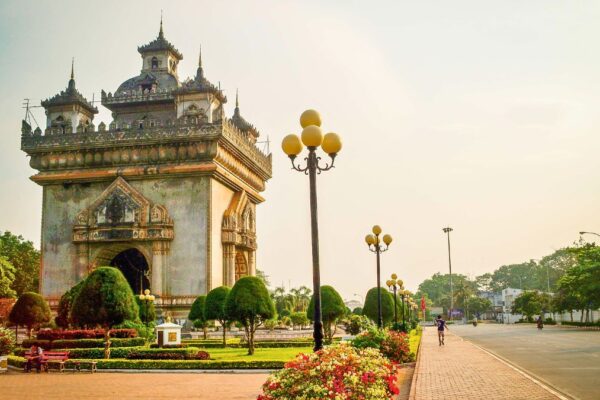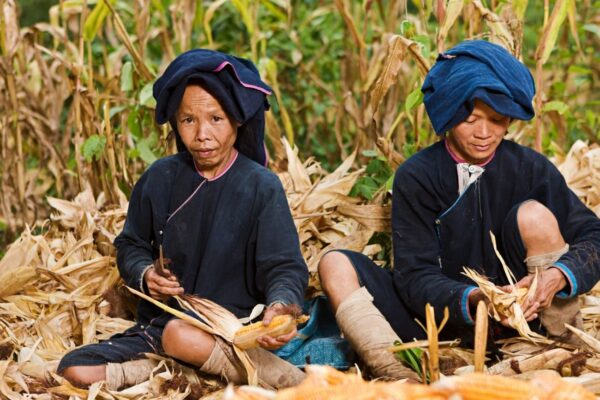Laos Experience Guide: The Ultimate Things You Can Only Do Here
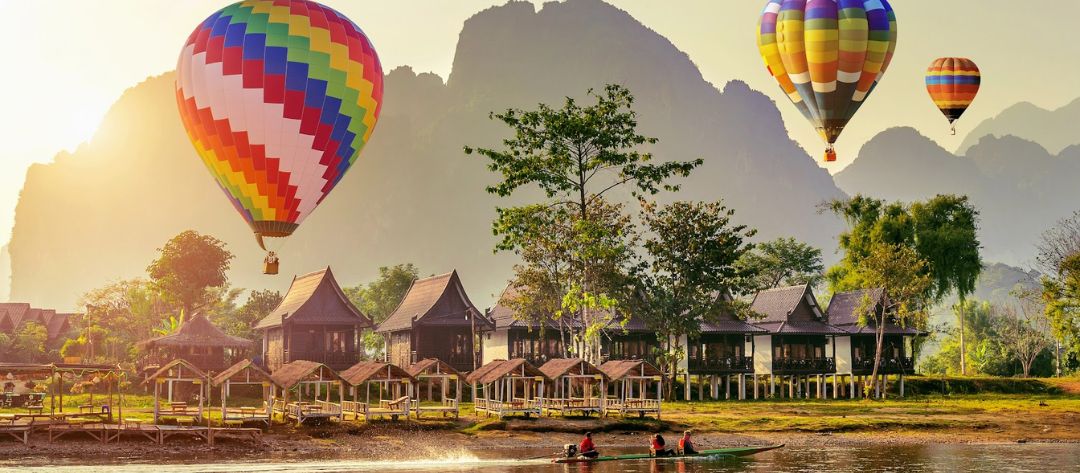
The only landlocked nation in Southeast Asia, Laos, is often seen as a stopover between Thailand and Vietnam. Yet beyond that reputation lies a country of rich traditions, striking landscapes, and quiet corners still untouched by mass tourism. Here are unique ways for the best Laos experience.
Why Laos Feels Like a Secret You Still Can Discover
There’s something quietly compelling about Laos—something that makes it feel like a secret waiting to be discovered rather than just another stop on the backpacker circuit. One reason is its gently unfolding pace of life: daily rhythms aren’t rushed, which leaves room for moments to linger, conversations to deepen, and scenery to sink in.
Journeys here often follow winding roads or quiet rivers, leading toward places that feel far removed from the usual flow of tourism. Culture is not staged or polished—it lives in the gestures, stories, and traditions that are an integral part of everyday life. Nature, too, shapes the experience: vast forests, gentle waterways, and mountain silhouettes that remain largely untouched by heavy development.
What ties it all together is a genuine warmth that greets travelers not with spectacle but with a simple, human connection.
>> You Will Love This Blog: Where to Visit in Laos for First-time Travelers?
The Laos Experience: A Diverse Journey You Can’t Afford to Miss
Nature’s Wonders: Waterfalls, Rivers & Islands
Kuang Si Falls
Around 30 kilometers south of Luang Prabang, Kuang Si Falls unfold in a series of limestone terraces where water tumbles into dazzling turquoise pools. Shaded forest paths wind alongside the cascades, creating a cool, refreshing escape from the city that enhances the Laos experience. Along the way, conservation projects such as a bear rescue center and a butterfly garden add another layer of meaning to the visit, blending natural beauty with quiet efforts to protect it.
Top Things to Do
- Swim in the shaded, calm pools: Especially the lower-tier pools (first and second), which offer safer, quieter spots to float and cool off.
- Hike up to the top of the falls: A steep, well-marked trail gives views down over the cascading tiers and into the forested valley beyond. The trail takes about 15–20 minutes one-way for many visitors.
- Visit the Tat Kuang Si Bear Rescue Centre: Just beyond the entrance, rescued Asiatic black bears live in more natural-style enclosures. It’s meaningful to see, and helps frame the environmental care around the site.
- Butterfly Park exploration: A short walk before entering the falls, this landscaped garden lets visitors observe species native to Laos, with guided paths.
- Picnic/relax by the falls: There are picnic benches and cafes just outside or close by. Taking a break with food, listening to water, and enjoying shade make the place as soothing as it is scenic.
Notes
- One pool near the main waterfall is considered a sacred site, so swimming there is prohibited. Be attentive to signage and local guidance.
- The trail to the top gets steep, muddy, and slippery, especially after rain. Wear good shoes and proceed carefully.
- Water temperature at the top pools tends to be colder, since they receive less direct sunlight. That can surprise visitors used to warmer lower pools.
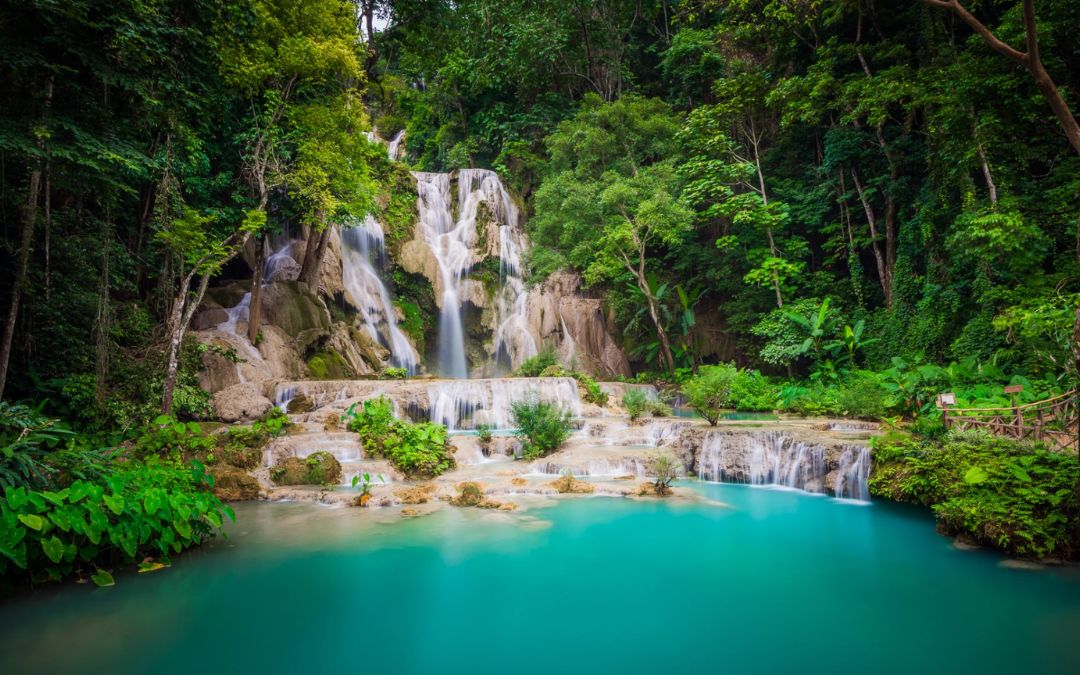
The stunning turquoise pools of Kuang Si Falls, blending natural beauty with peaceful tranquility.
>> Read More: Laos Travel Requirements Explained – Entry, Visas & Safety Tips
Khone Phapheng & Si Phan Don (4000 Islands)
Si Phan Don (literally “4,000 Islands”) is an archipelago in southern Laos along the Mekong River, mostly in Champasak Province. Scattered islands, some large and inhabited, others tiny and almost hidden, break up the flow of the Mekong into innumerable waterways.
At its heart lies Khone Phapheng Falls, which is not especially tall (the most significant drop is about 20–21 meters), but tremendously powerful and wide, with rapids stretching nearly 10 km in some places. The scale and force of the water, the shifting currents, and thousands of islets make this an immersive place where nature feels vivid, dynamic, and raw.
Top Things to Do
- Watch the falls from multiple viewpoints: Observe Khone Phapheng’s huge rapids and breadth from observation platforms; early morning or late afternoon light brings out contrast and color.
- Cycle between islands: Rent a bicycle and ride through Don Det, Don Khone, Don Khong, traversing rustic paths, rice fields, small villages, old bridges (including over water) to feel more of daily life.
- Visit colonial relics like the Old French Railroad Locomotive: On Don Khone & Don Det, there are remnants of the Don Det–Don Khon railway built back in the colonial period, which once helped bypass the rapids.
- Dolphin-spotting tours: Try to see the rare Irrawaddy dolphins in the Mekong, especially near the southern edges of Don Khone or Don Det, early morning or later afternoons are better.
- Relax by the river & enjoy beach spots: There are small sandy or pebbly beaches around some islands, especially near guesthouses; sitting by the water, drifting in a hammock, listening to the current.
- Explore local culture & temple life: Visit Wat Khon Tai on Don Khone (temple with Khmer carvings & local spiritual tone), or small museums that preserve colonial and fishing heritage.
Notes
- The flow of water around Khone Phapheng is extremely strong and unpredictable. Even where currents seem gentler, underwater hazards like submerged rocks exist. Therefore, swimming is unsafe in many parts. Always observe local warnings.
- Water levels vary dramatically with the seasons. In high water (monsoon or just after), many rapids and falls swell, making navigation harder and sometimes submerging viewpoints or paths that are safe in dry season.
- The Irrawaddy dolphin population is tiny and endangered, so spotting them depends much on luck, time of day, and weather. Tours are modest and non-intrusive, but expectations should be tempered.
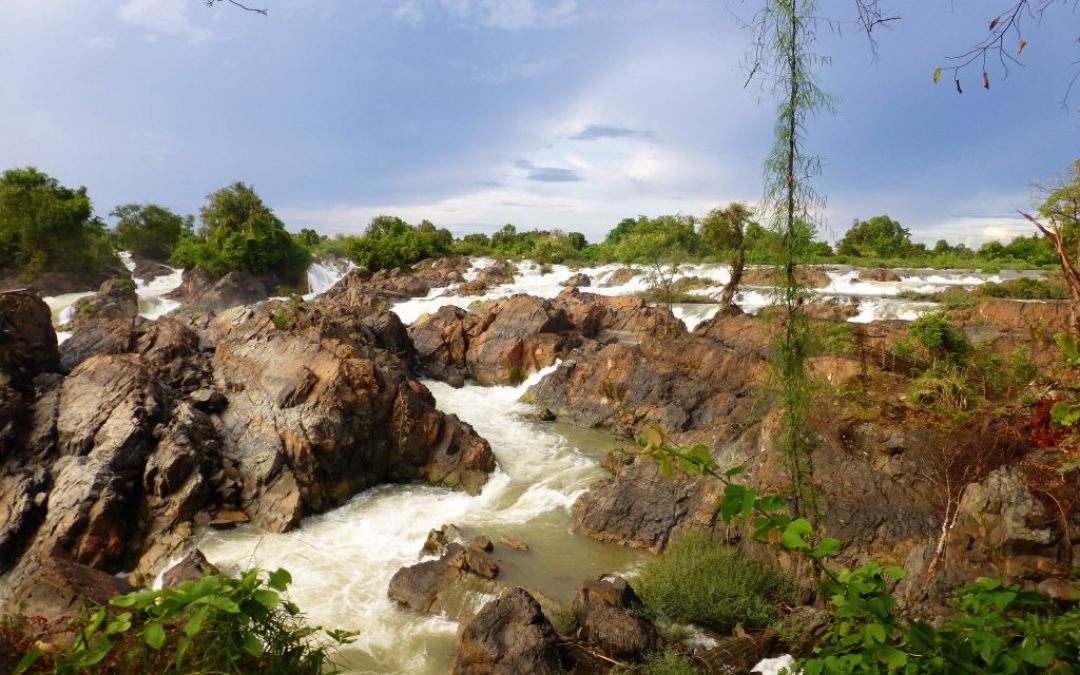
Si Phan Don’s powerful rapids and scattered islands.
Upper Mekong & River Cruises
The Upper Mekong River winds through northern Laos, carving deep valleys, lush forested banks, and remote river villages. Cruises here are available in many options, from boutique overnight boats to longer journeys lasting over a week. Such ways offer a chance to travel slowly, letting the scenery unfold with jungle-clad slopes, mist in the early morning, and riverside life that pulses with purpose.
Along the way, hidden caves, local cultures, and changing river moods make each day distinct. It’s a route where the river becomes the very thread of your Laos experience, tying together nature, culture, and history.
Top Things to Do
- Float upriver toward Pak Ou Caves: Take a longboat past riverbanks dotted with villages to reach caves packed with thousands of Buddha statues, aged and adorned with offerings.
- Visit village artisans and whisky-villages: Small stops like Ban Xang Hai give insight into Lao crafts, local distilling of rice whisky, and quiet moments beside the river.
- Choose a boutique overnight river cruise: Vessels like Anouvong or those on the Vat Phou route offer comfort, private balconies, fewer guests, plus meals onboard, time to watch sunrise over the Mekong, and relaxed pace.
- See the river from changing perspectives: Early morning or dusk light makes the riverbanks glow, mist rising, boats moving slowly—those photo-moments are worth planning around.
- Learn from local guides: Many cruises include storytelling, lectures, or guided walks, which bring meaning to what might otherwise be “just scenery”.
Notes
- River conditions shift with the seasons. Water levels vary dramatically, affecting navigability, visibility of riverbanks, and comfort. Certain routes may be passable only in dry or lean-flow months.
- Boats on longer stretches or boutique river cruises often have limited cabins. So, book ahead if traveling in the high season. Availability tightens especially for smaller, high-comfort vessels.
- Some viewing points and small stops along the Mekong are culturally sensitive or sacred. It helps to follow local customs and guidance, as what looks like open land may be private property or religiously significant.
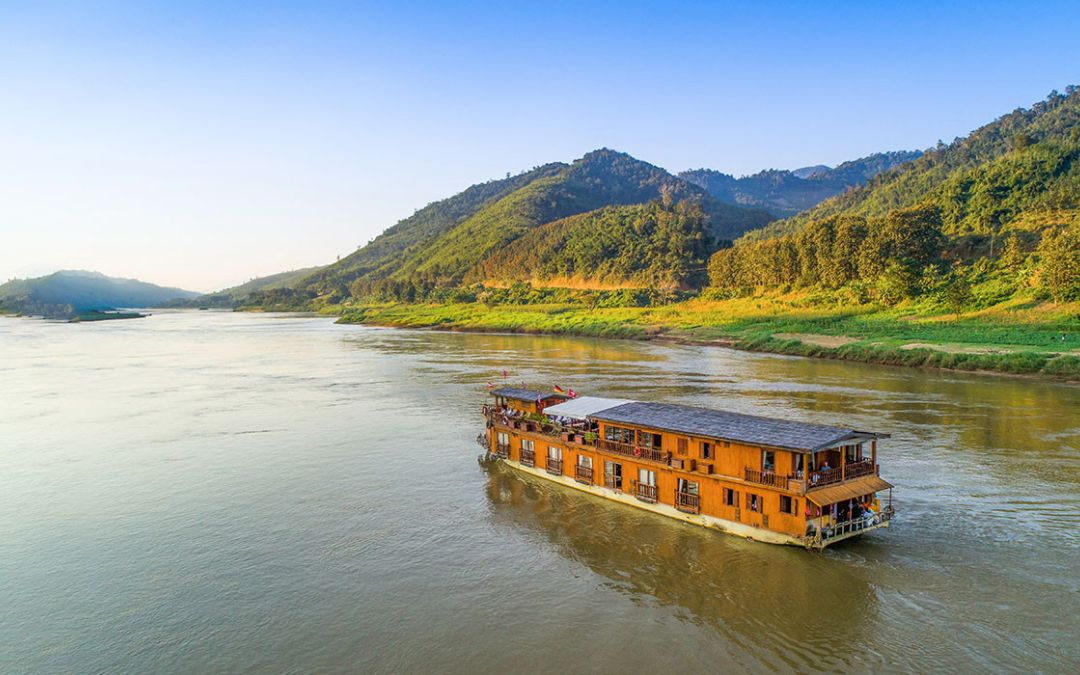
A leisurely Mekong River cruise provides an immersive Laos experience, connecting travelers with pristine landscapes and riverside culture.
Cultural Immersions: Rituals, Temples and the City Beat
Tak Bat (Almsgiving) in Luang Prabang
At first light in Luang Prabang, the city moves in hushed rhythm as saffron-robed monks walk single file through the streets. This centuries-old ritual, known as Tak Bat, reflects the deep bond between the monastic community and the local people.
Lay residents kneel quietly by the roadside, placing sticky rice and small offerings into the monks’ bowls. For the monks, this is their only meal of the day; for the locals, it is a way to earn spiritual merit and keep Buddhist traditions alive. The sight of saffron robes glowing in the soft dawn light has become the city’s most evocative Laos experience.
Top Things to Know
- A practice of reciprocity: Monks depend entirely on the offerings they receive, while locals gain merit and strengthen their spiritual life through giving.
- Rooted in Theravada Buddhism: The ritual embodies simplicity, humility, and detachment from material possessions, which are central values in the Lao Buddhist tradition.
- Silent connection: Both monks and locals remain quiet throughout the procession, symbolizing mindfulness and respect. This silence is as important as the act of giving itself.
- Women’s participation: While women are active participants in making offerings, cultural etiquette requires them to kneel lower than the monks and avoid direct physical contact.
- Community rhythm: Beyond the spiritual act, Tak Bat also reinforces a sense of shared identity, as neighbors gather outside their homes before the day begins.
Notes
- Avoid vendors who push tourists to buy low-quality food for offerings. The monks can only eat what is provided, so poor food quality undermines the spirit of the ritual.
- Cover shoulders, arms, and legs out of respect for both the monks and the Lao community.
- The ritual begins around sunrise and is usually finished by the time the streets fully awaken. Arriving early ensures a calm atmosphere before tourist crowds gather.
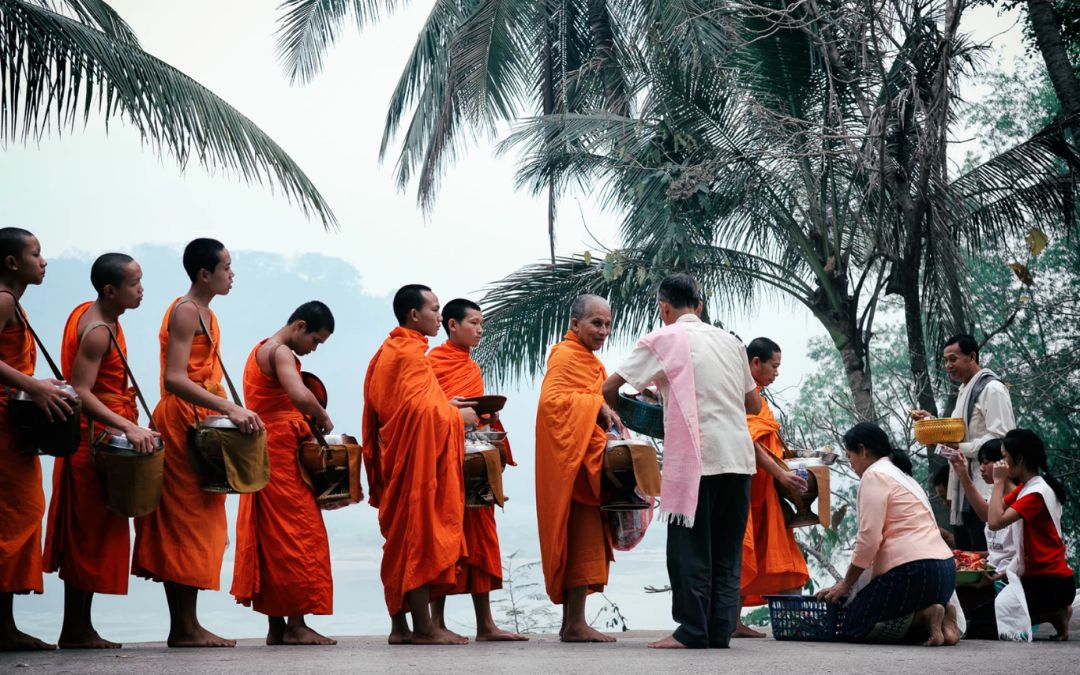
The sacred Tak Bat ceremony is rooted in centuries of Buddhist tradition and community devotion.
>> Read More: 7 Enchanting Laos Festivals and The Best Way to Experience Them Like a Local
Wat Xieng Thong
Perched at the northern tip of Luang Prabang’s peninsula, where the Mekong and Nam Khan rivers meet, Wat Xieng Thong (the “Temple of the Golden City”) is often considered one of Laos’s crown jewels. Built in the mid-16th century under King Setthathirath, it has long carried both royal and spiritual significance.
With sweeping multi-tiered roofs that seem to almost graze the earth, shimmering mosaics, carved wood, gilded ornamentation, and halls filled with Buddha images, Wat Xieng Thong offers a glimpse into centuries of Laos experience through craftsmanship, devotional life, and monarchical tradition.
Top Things to See
- Admire the Sim (Main Hall): That makes this hall a must-see is its low, layered, and gracefully curved roof structure, paired with interior gold stencils and painted panels narrating Lao legends and the life of the Buddha.
- The Tree of Life Mosaic: The rear wall of the Sim features a glass mosaic made in the 1960s reflecting cosmic symbolism—Heaven, Earth, Underworld—visible in vivid color and rich detail.
- Red Chapel (Sanctuary of the Reclining Buddha): Home to a rare reclining Buddha that was displayed in the Paris World Fair in 1931 before returning to Luang Prabang in 1964.
- Funerary Carriage Pavilion: The over 12-meter royal funerary carriage, which was once used in royal processions, stands as a marker of the temple’s tie to monarchy and royal ritual.
- That Makmo (“Watermelon Stupa”): A domed stupa with its distinctive rounded shape, also known as That Pathoum. It’s one of the unique stupas in Laos because of its style and symbolism.
Notes
- Wat Xieng Thong is still a working monastic temple and also holds deep cultural and royal significance. Some parts of the complex are used for ritual, ceremony, and worship. Visitors should stay aware of ongoing religious practices.
- The Reclining Buddha in the Red Chapel has had a dramatic history: its display abroad (in Paris, 1931) and return in 1964 mean it’s not only an object of devotion but also a symbol of Lao artistic identity and history.

Wat Xieng Thong’s exquisite architecture and royal heritage.
Vat Phou
At the foot of Mount Phou Khao in southern Laos lies Vat Phou, a temple complex that feels both timeless and deeply connected to the land. Recognized as a UNESCO World Heritage site, it traces its origins back as far as the 5th century and flourished under the Khmer Empire before becoming an important Buddhist sanctuary.
The design is unlike most other Khmer monuments: its terraces climb gradually toward the sacred mountain, with causeways, reservoirs, and shrines all leading the eye upward. Standing here, you sense how the builders wove their devotion into the natural contours of the landscape, turning the entire setting into a place of worship.
Top Things to See
- Processional Causeway: Stone pathways lined with weathered boundary markers that once guided pilgrims toward the sanctuary.
- Baray (Water Reservoirs): Large man-made pools that reflect both engineering skill and symbolic ties to Hindu cosmology.
- Palaces of the North and South: Twin structures that flanked the entrance, likely used for ceremonial or ritual functions.
- Sanctuary Ruins: The main temple area, with carved lintels and doorways still displaying depictions of Hindu deities such as Shiva, Vishnu, and Krishna.
- Sacred Spring: Flowing from the mountain, this natural spring has long been used in ritual purification, linking the temple to the landscape’s spiritual power.
- Views from the Upper Terrace: From the sanctuary, the sight stretches across the Mekong plains—an outlook that reveals why this place was chosen for devotion.
Notes
One of Vat Phou’s most distinctive features is its alignment with the mountain. Unlike most Khmer temples, which face east, Vat Phou looks directly toward the peak of Phou Khao. The mountain itself was believed to embody Shiva’s lingam, making the temple and the landscape inseparable in meaning—a rare blend of nature and sacred architecture.
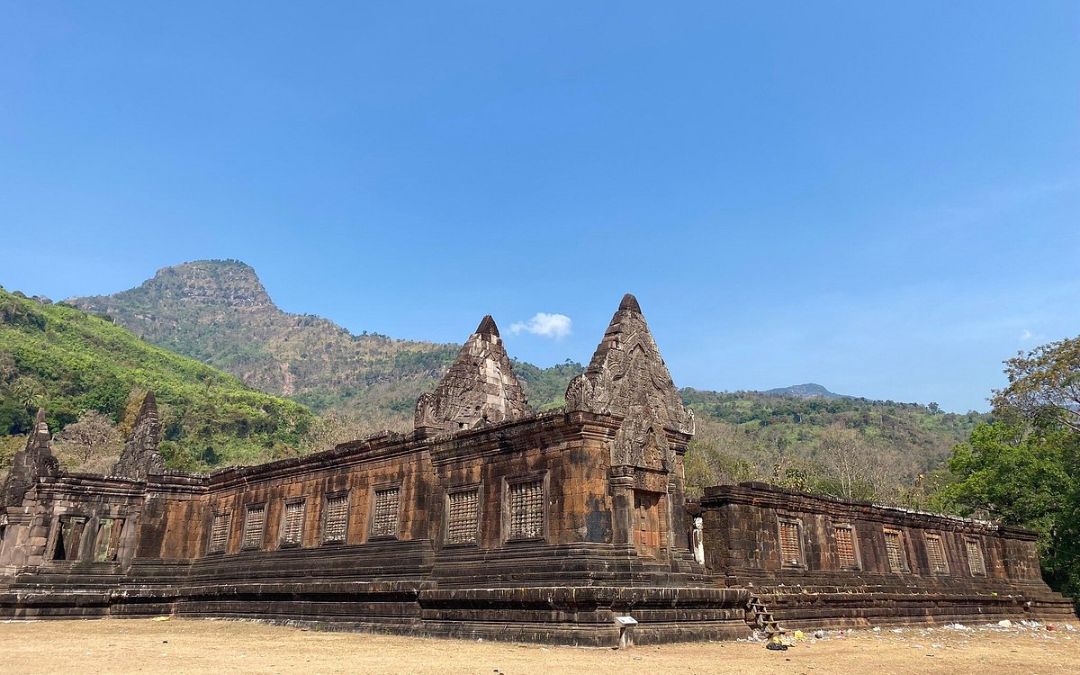
Ancient Vat Phou offers a timeless Laos experience where Khmer heritage harmoniously blends with sacred mountain landscapes.
Night Markets to Taste Lao Staples
Top Spots to Go
- Luang Prabang Night Market: Along Sisavangvong Road, this market transforms into a pedestrian-only stretch each evening from about 17:00–22:00. Here, craft stalls line the road and food vendors light up side alleys. It’s one of the most vibrant spots for both local snacks and more relaxed communal eating.
- Vientiane Riverside Night Market: Near the riverfront, this market offers both scenic views and good street food variety. The atmosphere leans a little more local and a little less crowded than big tourist markets.
- Ban Anou Night Market (Vientiane): Especially after dark, this spot fills with stalls and vendors offering Lao food classics. It’s a good choice for sampling a range of dishes in one place without the big-market bustle.
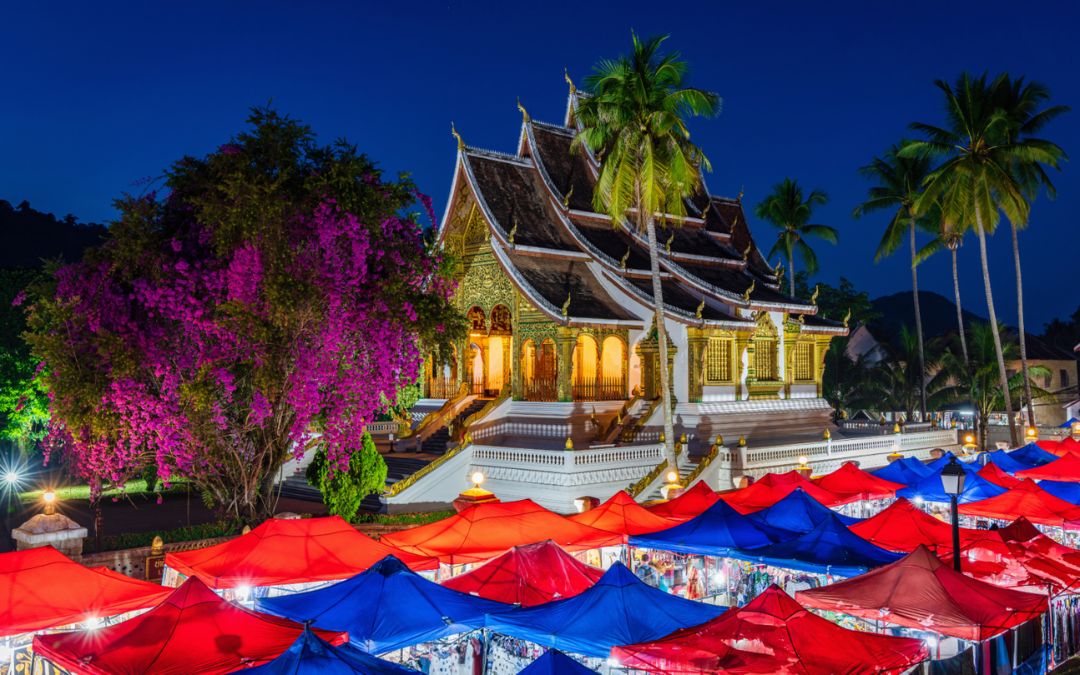
Luang Prabang’s vibrant night market, where local crafts and street food come alive under temple lights.
Top Dishes to Try
- Laab (Larb): A spicy, tangy meat salad made with minced pork, chicken, beef, or duck, fresh herbs (mint, coriander), lime juice, fish sauce or padaek (fermented fish), and toasted ground rice.
- Tam Mak Hoong: Shredded unripe papaya tossed with garlic, chilies, fish sauce or padaek, sometimes tomato, often crunchy and sharp. A common pick when something fresh and spicy is wanted.
- Mok Pa: Fish marinated with herbs (lemongrass, kaffir lime leaves, etc.), wrapped in banana leaf and steamed. Try to see how it’s gentle in texture and bold in scent.
- Khao Poon: A spicy noodle soup with coconut milk or broth, offered with your choice of meat (or fish) and herbs. Rich, fragrant, and often served hot at the night markets in Luang Prabang.
- Khao Jee Pâté (Lao Baguette Sandwich): This is the Lao twist on the French colonial baguette: filled with pâté, Lao sausage or pork, pickled vegetables, fresh herbs (cilantro, scallions), sometimes chili sauce.
- Sai Oua (Lao Herb Sausage): Pork mixed with Lao herbs and spices (lemongrass, chili, garlic, etc.) and then the mix is grilled. This bold, satisfying one is often paired with sticky rice.
- Jeow Bong: A sweet-savory spicy chili dip from Luang Prabang. It’s used for dipping sticky rice or vegetables, adding a burst of flavor that can be mild or fierce depending on the vendor.
Notes
- Tourist-heavy markets (like Luang Prabang’s main night market) often raise prices. Doing a quick walk-around to compare helps.
- Some dishes may be significantly hotter or more pungent than expected, especially when padaek or strong chili pastes are used. If not used to strong flavors, asking for “medium” or “less spicy” helps.
- Fish varieties, river herbs, and fresh produce might change depending on the weather, river levels, etc. So, what’s on offer one night might be different another night.
- Choosing stalls with high turnover (lots of customers) or ones where food is cooked fresh in front of you tends to be safer and more delicious.
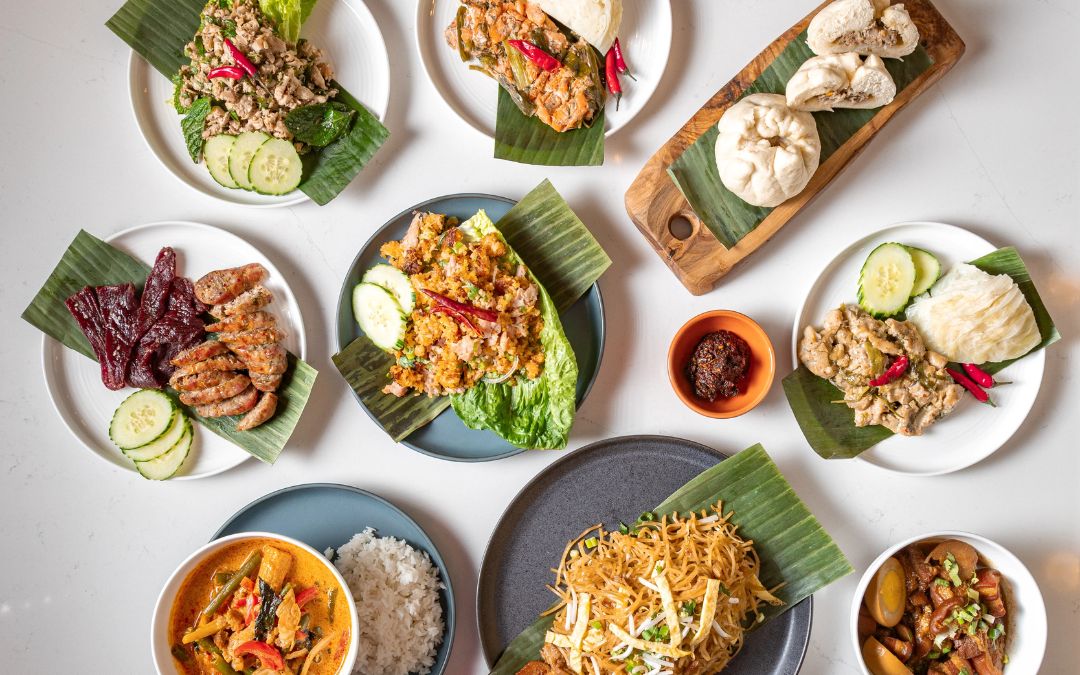
Traditional Lao dishes served on banana leaves showcase the authentic flavors.
Adventures for the Bold: From Caves to Mountain Ridges
Bolaven Plateau
High in the southern reaches of Laos, the Bolaven Plateau unfolds like a vast green canvas brushed with mist, waterfalls, and fertile fields. The altitude brings cooler weather, waterfalls tumbling over dramatic cliffs, and endless stretches of coffee plantations. Such a contrast to the hotter lowlands below.
This is also a land shaped by tradition—home to ethnic minority villages where time seems to slow, and landscapes where the wild still feels untamed. For travelers drawn to nature and adventure, the plateau offers a rare Laos experience blending of dramatic scenery and cultural encounters.
Top Things to Do
- Chase waterfalls: Marvel at Tad Fane’s twin cascades plunging nearly 120 meters into a jungle gorge, or take the trail down to the base of Tad Yuang for a close-up perspective.
- Explore hidden caves: Trek through forest paths leading to underground chambers such as the Houay Saetai caves, where limestone formations reveal the plateau’s geological story.
- Ride the loop: Rent a motorbike and circle the Bolaven Plateau loop, a scenic journey past remote villages, coffee farms, and endless waterfalls.
- Coffee plantation tours: Learn how Laos’ most famous crop is grown, roasted, and brewed, often with tastings offered by small family-run farms.
- Hike the ridges: For sweeping panoramas, follow trekking routes along mountain ridgelines that look down on misty valleys and rural farmlands.
Notes
- One unique detail about the Bolaven Plateau is its strong ties to ethnic minority communities, including the Alak, Katu, and Ta Oy groups. Many villages welcome visitors, but customs vary, so dress modestly and ask before taking photographs.
- Roads can be slippery during the rainy season, especially near waterfalls, so sturdy footwear is a must.
- While the cooler air is refreshing, evenings can turn surprisingly chilly, so a light jacket is worth packing.
- If traveling between November and February, you’ll catch the plateau during coffee harvest season. Plantations open their doors for tastings and tours, and the landscape itself is filled with the scent of freshly dried beans.

Bolaven Plateau’s dramatic waterfalls and misty highlands combine natural beauty with cooler mountain climates.
Thakhek & Loop Routes
The Thakhek Loop is a motorbike circuit in central Laos that winds through karst mountains, limestone caves, remote villages, and riverside scenery.
Originating and ending in Thakhek town, this route offers dramatic contrasts—from lush jungle and hidden grottoes to plateau vistas and often quiet roadways where few travellers pass. The Loop has earned its reputation among adventurous travellers seeking a mix of nature, culture, and raw landscapes that still feel like an uncharted Laos experience.
Top Things to Do
- Kong Lor Cave (Tham Kong Lo): A 7.5 km long river cave where a boat takes you through darkness, past towering caverns up to ~100 m high in some parts. Huge, atmospheric, it’s often cited as the crown jewel of the Loop.
- Explore “Cave Alley” Between Thakhek and Tha Lang: This stretch has a cluster of caves worth dipping into—Elephant Cave (Tham Xang), Buddha Cave (Tham Pa Fa), Pa Seuam Cave, and more. Forest paths, river-cave passages, and cultural touches (shrines, local life) make this section particularly rich.
- Cool Springs & Natural Baths: Stops like “Cool Pool” offer refreshment after long stints riding. Clear water, shade, sometimes floating docks or simple riverside seating make these lie-back moments memorable.
- Rock Viewpoint + Zipline at Phou Hin Poun: For panoramas, climb up or take an optional zipline/via ferrata or hanging walkways near “The Rock Viewpoint”. Jungle, karsts, valleys stretch out beneath. Particularly striking early morning or late afternoon light.
- Cultural Stops & Villages: Along the Loop, small villages offer weaving, local markets, food stalls, occasional temples. Stops like Ban Na Hin, Lak Sao, or Ban Kong Lor let you observe rural Lao life up close.
- The Drowned Forest & Scenic Plateaus: Sections like Nakai Plateau include landscapes marked by water reflections, dead trees emerging from reservoirs, quiet lakes, rice fields, making for slower but visually profound segments.
Notes
- Thakhek Loop is stunning, but many of its most scenic or adventurous sections are heavily affected by seasonal weather. After rains, dirt roads become muddy, rivers flood sections, and some caves (e.g., Dragon Cave) may be inaccessible or dangerous.
- Some forested, remote sections (like near Natan Valley) have very little cell reception and help services are sparse. Planning for dry-season travel, starting early each day, and allowing flex in your schedule are more than nice ideas.
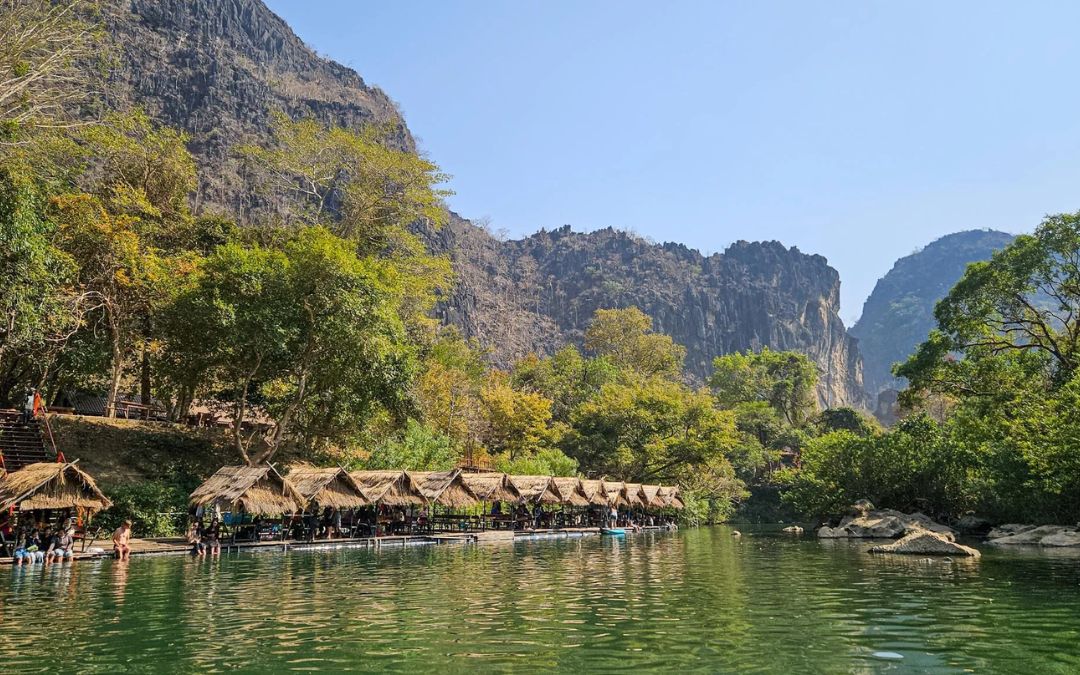
Thakhek’s dramatic karst landscapes and serene riverside setting provide an off-the-beaten-path Laos experience
Gibbon Experience & Canopy Stays
Deep in the Nam Kan National Park (formerly part of Bokeo Nature Reserve), the Gibbon Experience is a conservation story told from the treetops. Its framework is built around treehouses perched 30–40 meters above the forest floor, joined by zip lines, trails, and viewpoints. Amidst dense, mixed deciduous forest, you wake to birdcalls, maybe even distant gibbon calls, and each moment feels rooted in nature.
The project also supports local communities, many of whom now work as guides, cooks, or caretakers. Hence, staying up in the canopy becomes part of a conservation-driven Laos experience.
Top Things to Do
- Stay in the treehouses: Sleep high above the jungle floor in handcrafted treehouses. Some are private, others more communal, but all are built to blend with the forest and offer views over the canopy.
- Zip-lining between houses: Move from one treehouse to another using a network of zip lines. The longest lines are impressive, letting you glide over the jungle canopy and see the forest from above.
- Jungle trekking & wildlife spotting: Trails through the reserve let you explore flora and fauna, such as birds, insects, forest sounds, sometimes elusive mammals. Even if you don’t see a gibbon, the ecosystem feels alive. Guides help locate animal calls, point out plants, and explain forest ecology.
- Waterfall Trail: For a more immersive variant, there’s a version where part of the nights are in a treehouse near waterfalls. Trails along the Nam Nga River, swimming holes, and forest paths add texture to the adventure.
- Sunrise, forest sounds, morning mist: Waking up in canopy cabins allows moments many lodges can’t offer—the soft light over forest, mist rising, the symphony of dawn with birds, insects, and maybe gibbons. These sensory moments often become the ones remembered most.
Notes
- Treehouses here are high (30-40m) and remote, so there’s limited electricity (solar lights mostly), open-air showers, and simple facilities. The adventure includes climbing ladders or steep stairs, gear hauling via zip lines, and reliance on guides when moving between houses.
- While seeing gibbons is a major draw, sightings are not guaranteed. Therefore, you’ll likely hear them more often than see them. The forest is large, dense, and wild, and gibbons are shy. What is almost certain is hearing them at dawn or dusk. That alone creates a powerful sense of being deeply in nature. Choosing a longer tour (e.g. the Classic version) and staying more nights in the canopy improves the chances.

Canopy treehouses in pristine jungle are where conservation meets adventure high above the forest floor.
The Human Connection: Slow Days, Local Hosts, and Community Stays
Village Homestay
Staying in villages such as Ban Nayang offers Laos experience into daily life that hasn’t been polished for show. The Hmong here are known for intricate handwoven textiles, created on wooden looms in family courtyards, while Khmu communities open their doors with simple but generous hospitality. Nights are often spent in stilt houses, where meals are prepared from garden vegetables and forest herbs, giving guests both shelter and a living link to tradition.
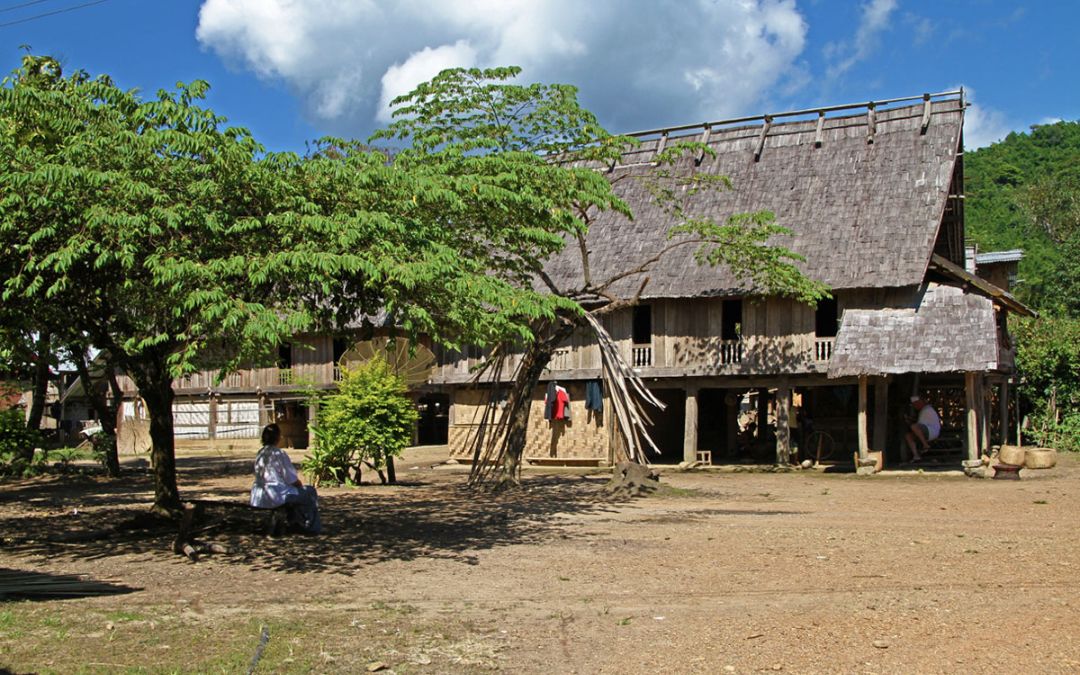
Village homestays in Ban Nayang immerse travelers in traditional ethnic minority culture and daily rural life.
Craft Workshops
Hands-on workshops add another layer of connection. Learning silk weaving from Hmong artisans or shaping bamboo into baskets under the guidance of Khmu craftspeople turns a skill into a memorable Laos experience. These workshops grant ways to sustain knowledge that has been passed down through generations and still forms part of everyday life.
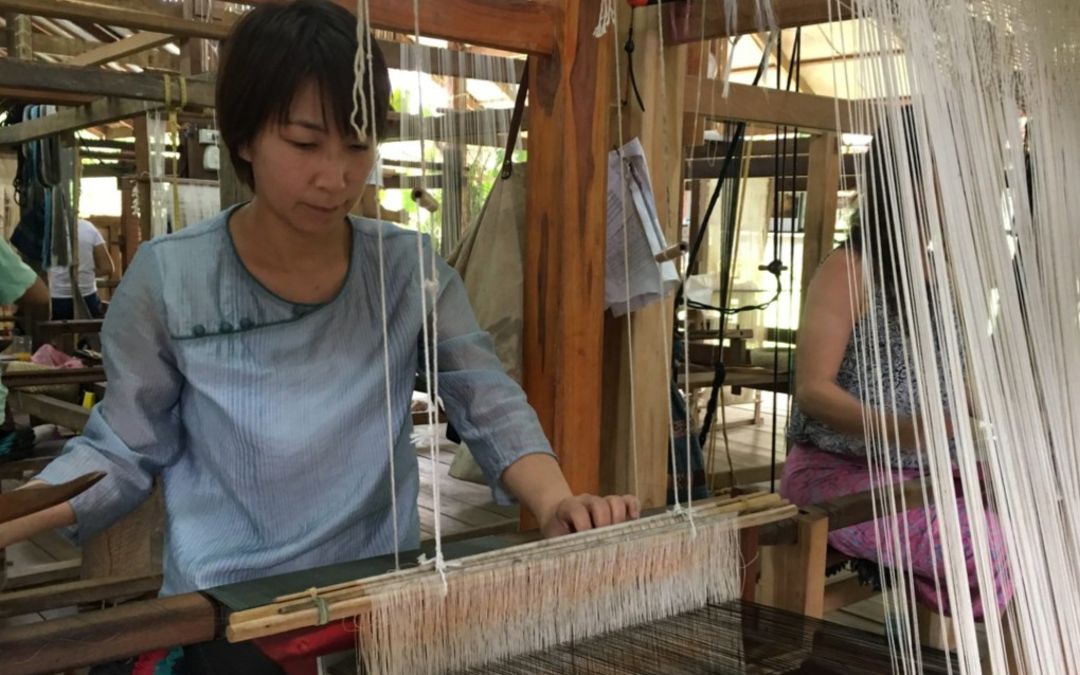
Traditional silk weaving workshops, where ancient craftsmanship skills connect visitors with living cultural heritage.
Morning Markets
Markets in small towns and villages pulse with an energy that is both social and practical. At dawn, baskets fill with river fish, bundles of fresh herbs, and warm sticky-rice cakes wrapped in banana leaves. Wandering through these gatherings offers an unfiltered Laos experience at how food, trade, and conversation anchor community rhythms.

Bustling morning markets showcase the heart of community life.
Community-Based Tourism
Many of these encounters are made possible by community-based tourism initiatives. By welcoming visitors, villages can maintain weaving traditions, conserve forest resources, and support education through shared income. For travelers, it means every stay or workshop is not only an enjoyable Laos experience but also a contribution to keeping cultural threads alive.
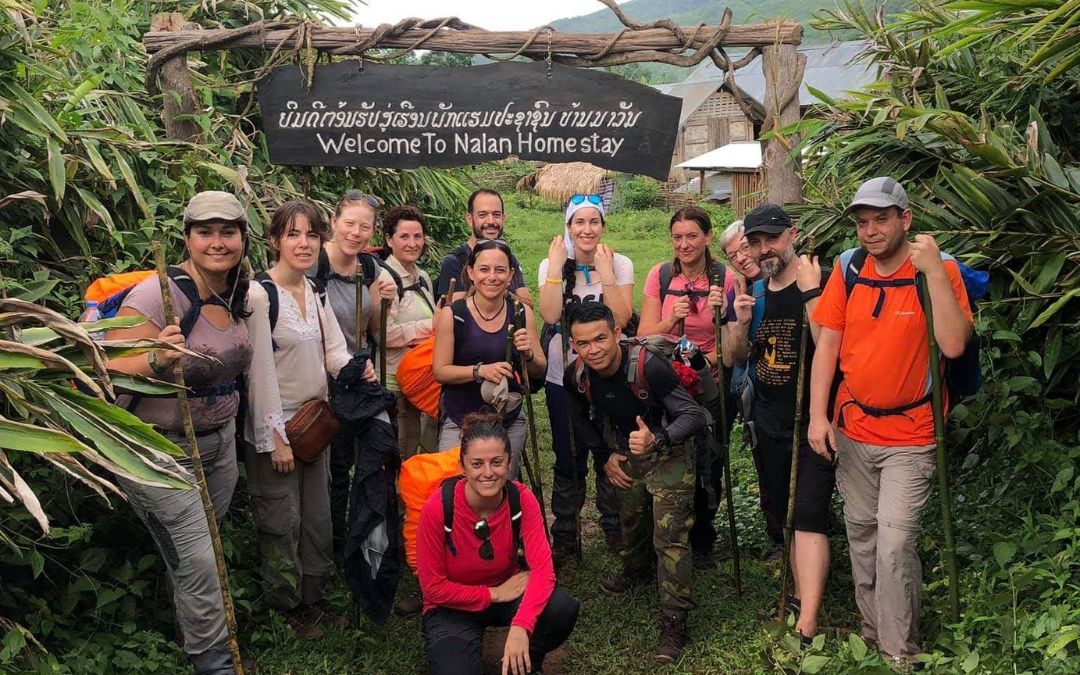
Community-based tourism initiatives, where travelers directly support local villages while preserving cultural traditions and natural resources.
Final Words
Laos might appear low-key at first glance, but a deeper look quickly proves otherwise. The country holds layers of character that reveal themselves in unexpected ways—temples tucked into mountain valleys, river journeys that slow time, and traditions passed down through generations. With its deep-rooted Buddhist culture and landscapes that change beautifully from season to season, every Laos experience becomes richer when approached with a little preparation and care.
When you’re ready to let these moments unfold, Asia Pioneer Travel can help turn them into a journey shaped around you. Reach out to start planning, and let Laos surprise you in the most unforgettable ways.
